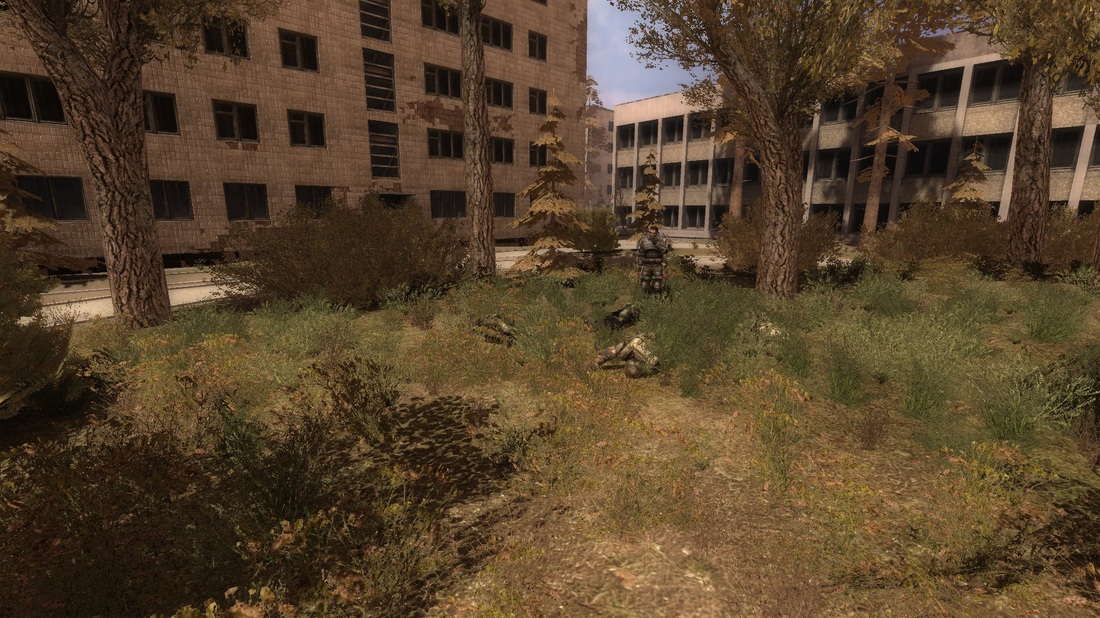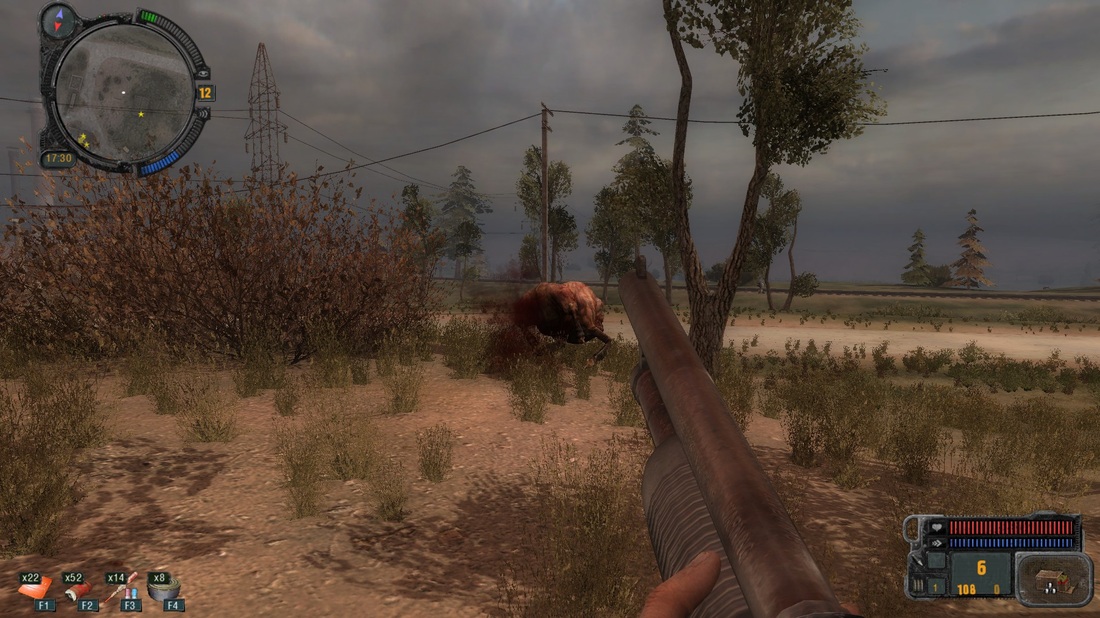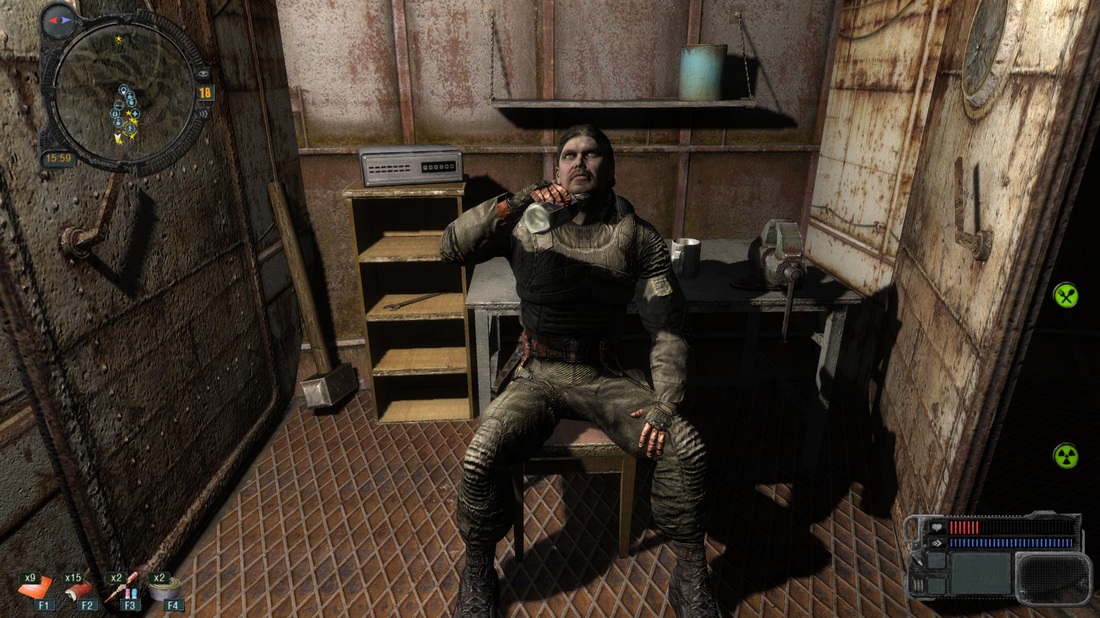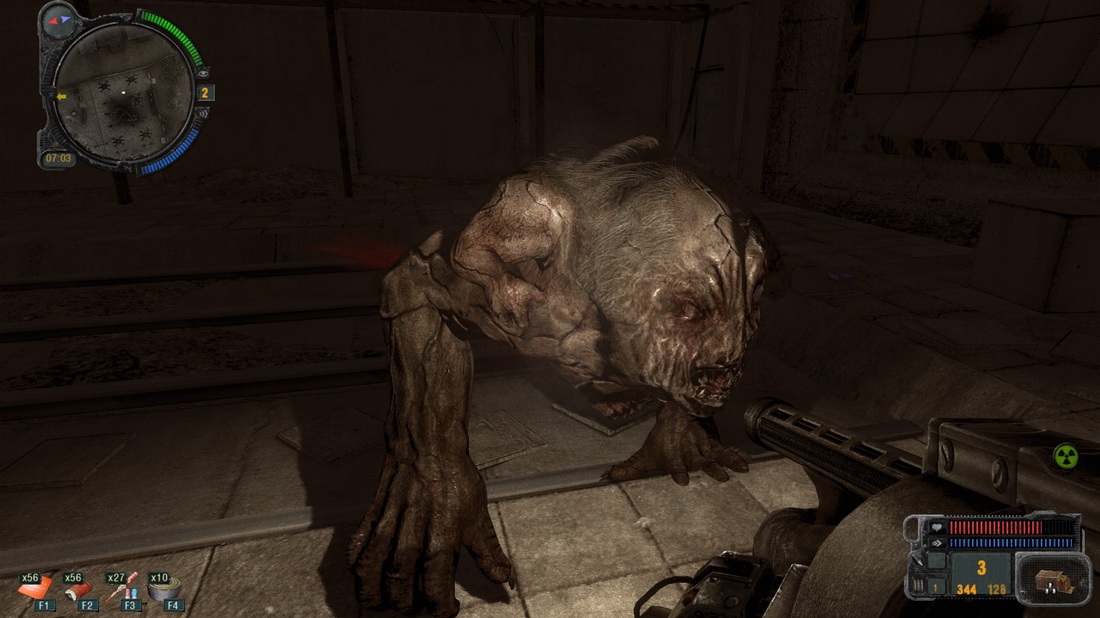 Suit up and pack some anti-rads. Suit up and pack some anti-rads. A squadron of military helicopters went down over the Zone. Now one soldier has to enter the zone, find out what went wrong, and help the remaining helicopter pilots and personnel complete their mission and get out alive. Survival is not assured.
1. Gameplay
Sometimes I run across a game that I feel has the potential to be great but just has a few rough edges to work out. Expansion packs and sequels are great for those rough edges. Stalker: Call of Pripyat is the sequel that should have ironed out all of the roughness from its predecessors, but for some reason didn’t quite get there. First, the positives. Call of Pripyat is by far the most stable game in the series. Where the first Stalker game would crash on me constantly, I don’t recall Pripyat ever crashing on me. While that may seem like something that should be expected with a game, I have to give some credit to a studio that works on PC-only titles. This is especially true for Pripyat, considering the amount of bugs and stability issues in the previous Stalker titles. This game can be thoroughly terrifying when it tries. It’s not about jumpscares or cheap stuff like that. This game can put the player in a dark, claustrophobic environment and, regardless of if there are enemies or not, leave the player truly frightened. Yes, the player has a flashlight and night vision, but that isn’t always enough. I’ll give you an example. I’m going through an underground laboratory facility. I kill a few monstrous enemies and get to what I presume is the cafeteria area. On the left I see a door and, to my surprise, from behind this door I hear a baby crying. This facility had clearly been abandoned for a substantial time, so the likelihood of a baby being behind this door is non-existent. I know it’s a monster. But my curiosity gets the better of me and the tension mounts as I approach the door. As I open the door… This scenario highlights the greatest points in the game. This game can be seriously tense and the lighting, sound, and tension all feed off each other and create an environment that is suspenseful, yet always allows the player to be curious. You know there might be something horrible lurking around the next corner, but you always want to take that corner anyway. Unfortunately those moments are so sparse that I struggled through certain points of this game. So much of the time is spent on the surface, where the tension is completely lost and the atmosphere doesn’t tell any real story or give anything interesting for the player to look at. The player is hooked whenever he is underground, but the second he returns from the depths this game loses so much. My other major complaint is that the missions are extremely difficult to find. In some ways that was clearly intended, but in others I felt really short-changed. In reality, the number of missions that I ended up completing was extremely small. Outside of the story-related quests, there were only a couple dozen things to do. In an open world game that encourages exploration, that hurt quite a bit. Obtaining quests was sometimes as difficult as figuring out what to do once you had said quest, which certainly didn’t help. If you can ignore (or, better yet, solve) the stability issues, I would recommend Stalker: Shadow of Chernobyl way before this game. Call of Pripyat felt like a watered down version of that. If you find you’ve enjoyed that and want more, either go for the Clear Sky expansion pack or this game.
It took me around 17 hours to complete this game but I feel like I really took my time. I tried to find a complete all of the missions and I made sure to stockpile and sell everything I could get my hands on. When most of my time is spent walking around a wasteland so I can sell a few guns, the game can definitely feel long. This game felt really long (and not in a good way).
There were two things that definitely left me frustrated about this game. First, navigating around the worldspace could be very difficult. I was constantly looking at my map because the worldspace lacked many identifiable landmarks. While the areas felt sufficiently different that I could tell when I was in one area or another, I had a difficult time determining my direction of travel without constantly looking at my map. This issue was especially problematic when I was looking for missions or mission-related items. Unless there was a map marker pointing me to exactly where I had to go, I was completely in the dark. The only other issue was how powerful some of the enemies were. The game is designed to include some “survival” type elements. Enemies will be relatively easy to kill once they’re damaged enough (which usually doesn’t take long), but they deal out just as much damage. Even with the best armor I could occasionally find myself near-death within seconds of starting combat. Normal enemies (the ones that use guns) weren’t a huge deal provided the player sticks to cover and makes each shot count, but the mutated enemies tended to deal a ton of damage and have surprisingly large amounts of health. There were plenty of battles where I felt more frustrated than what seemed necessary. 2. Parental Notices
Violence in this game is surprisingly mild for a first-person shooter. Most of my playtime was spent travelling between destinations. During travel on the surface, most combat scenarios can either be avoided or simply don’t exist. The player will have to fight the occasional monster or bandit, but most of my brief surface combat was spent shooting feral dogs. When the player actually engages in combat, hits from all weapon types will result in a small puff of blood but little else. This can be exacerbated or mitigated depending on the distance from the player to the target, the type of weapon the player uses, and whether the weapon is rapid fire. Shotguns and fully automatic rifles will result in more visible blood, but all blood goes away very quickly. Explosions do not cause any sort of additional blood or gore. The only possible gore comes when the player scores a headshot with a shotgun or sniper rifle on a human enemy. In this case, sometimes the player can completely destroy the enemy’s head. However, this was extremely rare.
Sexuality is not a factor in this game.
Substances are included in this game but, for the most part, are not a major factor. The player will be able to pick up a few different types of substances (or what can be presumed to include substances). The most commonly used “substance” are the medkits that the player will need in order to heal wounds. While bandages will only stop bleeding, something within the medkits will actively heal wounds. This magical healing substance is never specified. The player will also need to get rid of radiation. In order to do this he can use anti-radiation pills. There is no animation associated with using an item. When the player “uses” the anti-radiation pills, he can hear a pill bottle open and the main character swallows. There are other types of drugs that can have different effects. Most of these are intended to be used in an emergency (i.e. the drug that protects the main character during an emission). However, some can have more recreational effects. For example, the player can drink an energy drink which greatly increases the rate at which stamina is replaced. The player can also drink some sort of alcohol. Drinking the alcohol does have some positive stat-related effects but causes the screen to swim (which can make combat very difficult). The player can give the alcohol to a repairman who supposedly is able to perform better repairs when drunk. However, if the player gives him too much alcohol he’ll pass out. There’s no lasting effect for the main character.
Gambling is not a factor in this game. 3. Other Factors
There are a very limited number of mods for this game. There are a few that change the visuals or the story, but most are meant to modify the weapons, characters, and visual quality. I could not find any mods that increased the amount of mature content in this game.
Religion plays an extremely minor role in this game. One of the enemy factions the player will face are known as “Monolith”. They worship a strange sort of signal by creating large shrines of junk around communication devices. These devices seem to give them orders (although the characters do notice that the signal seems to have stopped recently). The player can see some of these characters praying to one of the shrines.
There are factions in the area and a few of these factions are in open conflict. However, the amount of actual war or combat between these factions is minimal. In any case, there is no local law enforcement and no written laws to uphold. As a result, anti-law is not a factor in this game.
The multiplayer modes are no longer functioning for this game.
Extreme sports are not a factor in this game.
While everything in this game is designed to be biologically or chemically related, there are plenty of items and enemies that don’t go into any sort of detail as to how they are able to perform actions and effects. For example, the player can pick up small objects known as anomalies that can have some interesting and helpful effects such as healing, allowing the player to carry more weight, or protecting the player against other effects. However, the game does not explain exactly how these anomalies work, leaving the radiation alone as enough explanation. Enemies can have similarly “magical” effects. There are a number of enemies that can move objects telekinetically or attack the player’s mind directly. While these abilities may be the result of the mutation these creatures underwent, the game never specifies in enough detail to clearly exclude this from the category of magic. However, this game does not include any sort of “traditional” magic (chants, spells, etc.).
Human Disfigurement A number of the enemy types are designed to look like mutated people. These can range from the benign zombies (that are basically just dumb soldiers) to the seriously messed up Controllers (which are clearly human but with some insane growths on their heads and bodies). Most of the serious mutations are fairly rare, but they can definitely be creepy. Scary Images I debated including this one since there aren’t any specific scary images or jump scares or anything of that nature. However, a number of the missions and areas are definitely creepy and can play tricks on anyone who isn’t “strong” enough to handle serious tension. It’s not going to be horror-levels of fear, but it might be a bit much for a younger audience. Suicide
In one mission the player finds a character who has been killing other Stalkers. When the player confronts this character, the man kills himself.
0 Comments
Leave a Reply. |
Like what we do? Want to see more? Donate to the site using the button below!
Not sure what a term means? Read the definitions!
Not sure what a review section is about? Find out more information!
|













 RSS Feed
RSS Feed